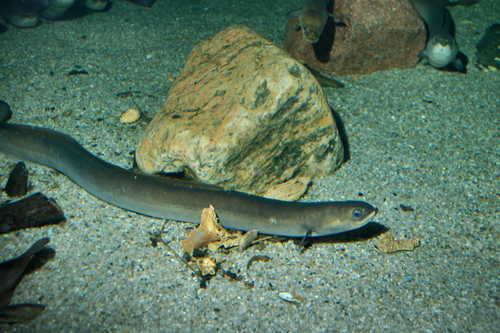Eel
Anguilla anguilla
Eels are most likely to spawn in the central parts of the Sargasso Sea. The sagittaria-shaped larvae then drift with the Gulf Stream and with help from the North Atlantic westerly wind towards the coasts of Europe.
At the continental shelf, the 12-15 month-old larvae metamorphosise into glass eels. During the spring months, the clear elver actively seeks to make its way towards the coastal areas with the help of surface flows.
Migrates to freshwater
Some of the elvers remain in the saltwater, while the rest migrate to freshwater. In freshwater, the elver seek to make their way towards the bottom and gradually become dark on the back and yellow on the belly. They then become known as yellow eels.
The yellow eel is a predator that eats snails, crustaceans, insects, worms and fish.
Two types of eel are prevalent in lakes: a sharp-nosed type and broad-nosed type. The sharp-nosed eel lives on the lake bottom, where it mainly feeds on insect larvae. The broad-nosed eel lives in the lake's reedbed, where it eats fish fry.
From yellow eel to silver eel
The growth phase as a yellow eel usually lasts 5-15 years, after which the yellow eel becomes a silver eel. This is an adaptation to the approximately 6,000 kilometre-long spawning migration that it has to make to the Saragosso Sea.
The male eel's metamorphosis into a silver eel happens when it reaches a length of 33-45 centimetres and for a female eel when she is 42-100 centimetres.
Facts about eels
Prevalence in the river Kongeå:Prevalent in Kongeåen's mainstream and suitable tributaries.
Weight: Largest Danish eel 3.1 kg. Caught in 1997 in Frederiksborg Castle lake.
Age: Rarely older than 15 years, but can be older.


